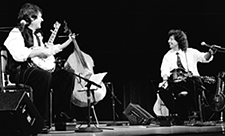

From the back balcony of Finney Chapel, Mike Marshall's shaggy and bobbing curls looked more like a Sesame Street puppet than the head of a musician. Marshall did, in fact, entertain the audience with the silliness and excitement of a jester, but the exacting skill he demonstrated with his mandolin was far from flippant.
His contemporaries were no exception: Béla Fleck and Edgar Meyer, two of the most reputable string musicians in the world, joined Mike Marshall on Monday night to charm and inspire Oberlin students with their talents.

Their fingers moving quickly enough to feign stagnancy, Fleck on the banjo and Marshall on the mandolin provided the trio's tunes with spunk and melody. Meyer, romantic and engaged, added a robust timbre to the music with the low call of his bass. And together they jammed.
Their chemistry and collective zeal for music provoked these longtime friends to play for over three hours, no doubt inspired by the audience's ebullience. In appreciation of the crowd's attentiveness, Fleck praised, "You are so enthusiastic but you really listen." With six (count them-six!) standing ovations, it was evident that the audience was enamored.
Even as the trio opened, it was clear the night would be a success. The contrast between the moaning bass and shrills of the banjo and mandolin instantly filled the chapel with a richness. The second song, consisting of a call and response between the instruments was both somber and chipper, perhaps foreshadowing the variety of styles which the trio would explore.
Making dramatic faces at each other, Fleck and Marshall teased each other as well as their instruments. The audience responded with audible giggles, which soon progressed into the laughter that would continue through to the trio's second encore.
Prior to introducing "Duet," a song written by Meyer for-ironically-a group of three musicians, Fleck introduced Meyer and Marshall. Then, of himself, he added, "Of course, I always enjoy playing with myself." This is one example of the trio's casual wit, a trait which invited and maintained the attention of nearly every audience member.
Announcing the end of the first set, Marshall alluded to their own influences by stating that they would take a "traditional trio brownie break." They did not exit the stage, however, without first demonstrating the versatility of their talent. In "Sliding Down," the musicians swapped instruments, Meyer running back and forth from piano to bass and back to piano again. Varying the genre, they also played a fugue for three parts written by Bach.
As Meyer is best known for his work as a classical bassist, it is no surprise that the second act showcased other classical selections, including a piece intended for the violin, modified by Meyer for the bass and mandolin.
The three men showed tremendous camraderie in their respect for one another; while Meyer's genius was appropriately admired, so too was Fleck's. Marshall, prefacing Fleck's solo performance of "Swing Low, Sweet Chariot," acknowledged, "He's done a lot to bring attention to instrumental music for all kinds."
In fact, each of these three musicians has made their contributions to bluegrass, classical, funk and international music. Proving this, they closed their first encore with a series of Irish jigs so impressive that the musicians were once again beckoned back to the stage.
Meyer, Fleck and Marshall have not only impacted music history, but, surely, the trio also created a lasting impression on each individual present for Monday night's concert. Meyer caressed his bass, Marshall frisked his mandolin and Fleck's banjo shimmered like an extension of his arm. So it went into the night. The trio were stunning and charismatic both as musicians and performers.
Among friends: Friends and musical collaborators Béla Fleck, Edgar Meyer, and Mike Marshall won over the crowd and made even more friends in Monday's performance. (photo by Zach Fried)
Copyright © 1998, The Oberlin Review.
Volume 127, Number 5, October 2, 1998
Contact us with your comments and suggestions.